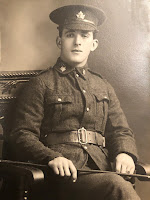Allan was living in Mosten, Saskatchewan and working as a farmer when he enlisted with the 183rd “Manitoba Beavers” Canadian Overseas battalion in Saskatoon, Saskatchewan on April 10th, 1916. He was 20 years of age and indicated that he had no previous military service. He was recorded as standing 5 feet, inches tall and weighing 135 pounds. He sported a fair complexion, blue eyes and dark brown hair. He listed his religion as Methodist. Allan was unmarried and listed his father Frank Lonsberry of Warsaw, Ontario as his next of kin.
He left with the Beavers when they left for Camp Hughes, Manitoba during the summer of 1916. After several months in camp the understrength battalion entrained and headed for Halifax where they boarded the SS Saxonia on October 4th 1916 for overseas.
Lonsberry arrived in England on October 26th and was posted to the Canadian camp in Witley. Upon arrival, the 183rd, like most Canadian battalions at the time, were broken up and re-assigned to other units. Lonsberry was one of a large draft initially assigned to the 100th Winnipeg Grenadiers. He would continue to train in England with that battalion, spending a couple of weeks in an English hospital in December with measles, before he was redeployed on January 12th in the 11th Reserve battalion.
The next step in Lonsberry’s journey came on February 3rd 1917 when he was taken on strength with the 107th “Timber Wolves” Pioneer Battalion, with which he arrived in France with at the end of the month. Though this unit was originally trained to fight as infantry, it had been re-designated as a unit that would carry out labour and and limited engineering tasks. Upon arriving, the Timber Wolves joined the Canadian Corps in their preparation for the assault on Vimy Ridge. In this sector, the Pioneers spent the next 2 months digging and repairing trenches, constructing dugouts, tunnels and shelters, hauling ammunition, burying telephone cables, erecting and repairing barbed wire fences, building roads, laying tracks for light railroads from rear area supply depots to the front and building plank roads so artillery could be pulled forward through the mud.
During the battle which launched in the early hours of April 9th 1917, Sapper Lonsberry with the 107th played an important and often dangerous support role in keeping the roads, tracks and trenches open and the troops moving and supplied as they pushed forward.
In August, the 107th with the Canadian Corps, played another important role in the Battle of Hill 70, where it followed the leading assault troops. Of the 600 soldiers engaged, 21 were killed and approximately 140 wounded. After this battle, one company volunteered to search for and bring in the dead and wounded. In all, the company recovered 30 dead and carried 25 wounded to dressing stations, for which the soldiers received high praise.
It was during this battle that Lonsberry was himself reported wounded by a gas shell on August 21, 1917. Suffering from a hoarse breathing, temporary blindness and severe chest pains, he made his way from the front to the casualty clearing station and then by ambulance to the No.30 General Hospital in Calais, before being evacuated to the War Hospital in Chester England on the 26th.
Sapper Lonsberry recovered from the worst effects of the gassing by September 30th, and was moved to the Canadian Convalescent Hospital at Woodcote Park to continue healing. Another 3 weeks were required before being discharged to the Canadian Casualty Depot on October 19th, with which he stayed with until January before moving on to the 18th Canadian Reserve Battalion until March 1917. On the 21st of that month he was transferred to the Canadian Engineer Training Depot in Seaford before being selected among a draft to be sent to the reinforcement pool in France on April 10th.By June 21st 1918, nearly ten months after being evacuated to England, Lonsberry rejoined his old unit, the 107th Timber Wolf Battalion in France. He remained with that unit until the end of the war. He returned to England on April 17, 1919 and was shipped back to Canada on the 10th of May. Lonsberry was formally discharged on May 23rd 1919 in Toronto, Canada, he returned to the village of Warsaw on June 4th 1919.
Sources
Canada.
"Military Service File of Allan Lonsberry." Library and Archives
Canada, Ottawa: Record Group 150, Accession 1992-93/166, Box 9692-57. Item
Number 269279.
Evening
Examiner. Photo “Pte. A.G. Lonsberry”.
September 20 1917. P.5
The
Canadian Encyclopedia. “107th
Timber Wolf Battalion”. March 10, 2024.[www.thecanadianencyclopedia.ca/en/article/107th-timber-wolf-battalion]


















